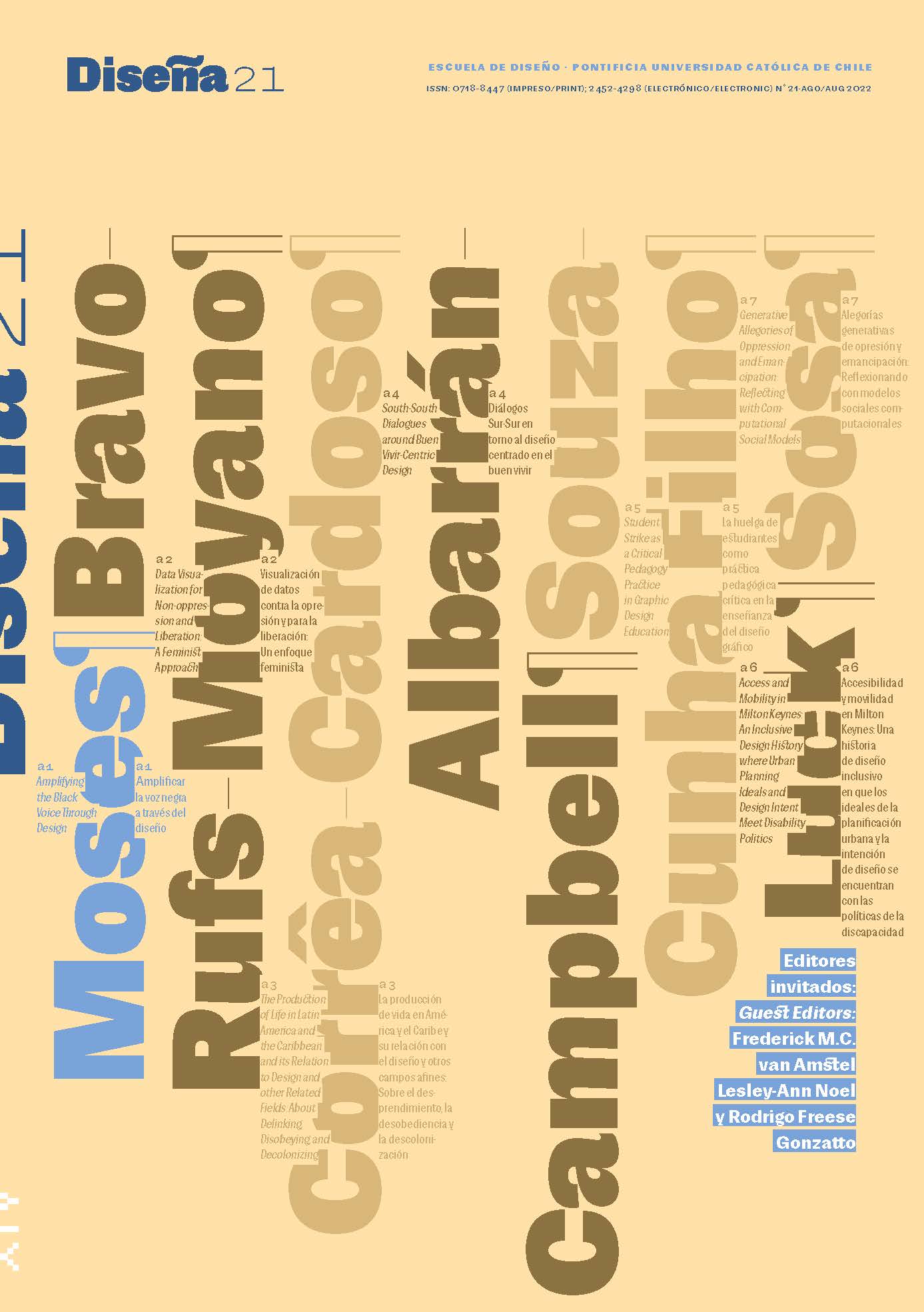Generative Allegories of Oppression and Emancipation: Reflecting with Computational Social Models
Main Article Content
Abstract
This paper presents a computational approach to growing artificial societies (agent-based simulations) as an explicit, accessible, and systematic tool to visualize and generate insights and new questions about Paulo Freire’s concepts of oppression and emancipation. These models do not make claims of validity or prediction, instead, their value is to structure our thinking and support our understanding. Here, I use computational social simulations as generative allegories to reflect upon the role of designers in participatory, co-design, and social design contexts. The paper shows how Freirean ideas can help reframe design as a pedagogical craft based on dialogue and collective inquiry.
Downloads
Article Details

This work is licensed under a Creative Commons Attribution-ShareAlike 4.0 International License.

This work is licensed under a Creative Commons Attribution-ShareAlike 4.0 International license.
COPYRIGHT NOTICE
All contents of this electronic edition are distributed under the Creative Commons license of "Attribution-ShareAlike 4.0 Internacional" (CC-BY-SA). Any total or partial reproduction of the material must mention its origin.
The rights of the published images belong to their authors, who grant to Diseña the license for its use. The management of the permits and the authorization of the publication of the images (or of any material) that contains copyright and its consequent rights of reproduction in this publication is the sole responsibility of the authors of the articles.
References
Amir, S. (2004). Rethinking Design Policy in the Third World. Design Issues, 20(4), 68–75. https://doi.org/10.1162/0747936042311995
Axelrod, R. (1997). The Dissemination of Culture: A Model with Local Convergence and Global Polarization. The Journal of Conflict Resolution, 41(2), 203–226. https://doi.org/10.1177/0022002797041002001
Bertolotti, F., Locoro, A., & Mari, L. (2020). Sensitivity to Initial Conditions in Agent-Based Models. Multi-Agent Systems and Agreement Technologies: 17th European Conference, EUMAS 2020, and 7th International Conference, AT 2020, 501–508. https://doi.org/10.1007/978-3-030-66412-1_32
Carley, K. M. (2002). Simulating Society: The Tension Between Transparency and Veridicality. Proceedings of Agents 2002, Chicago.
Chomsky, N. (2013). On Anarchism. The New Press.
Costopoulos, A. (2015). How Did Sugarscape Become a Whole Society Model? In G. Wurzer, K. Kowarik, & H. Reschreiter (Eds.), Agent-based Modeling and Simulation in Archaeology (pp. 259–269). Springer. https://doi.org/10.1007/978-3-319-00008-4_11
Dennett, D. C. (2013). Intuition Pumps and Other Tools for Thinking. Norton.
Epstein, J. M. (1999). Agent-based Computational Models and Generative Social Science. Complexity, 4(5), 41–60. https://doi.org/10.1002/(SICI)1099-0526(199905/06)4:5<41::AID-CPLX9>3.0.CO;2-F
Escobar, A. (2018). Designs for the Pluriverse: Radical Interdependence, Autonomy, and the Making of Worlds. Duke University Press.
Freire, P. (2000). Pedagogy of the Oppressed. Continuum.
Gero, J. S., & Sosa, R. (2002). Creative Design Situations: Artificial Creativity in Communities of Design Agents. Proceedings of the 7th International Conference on Computer Aided Architectural Design Research in Asia, 191–198. https://doi.org/10.52842/conf.caadria.2002.191
Gilbert, N. (2002). Varieties of Emergence. In C. Macal & D. Sallach (Eds.), Proceedings of the Agent 2002 Conference on Social Agents: Ecology, Exchange, and Evolution (pp. 41–50).
Gilbert, N. (2005). Simulation for the Social Scientist (2nd Ed.). Open University Press.
Gilbert, N. (2019). Agent-Based Models. Sage.
Kina, V. J., & Gonçalves, A. (2018). The Continuing Relevance of Paulo Freire: Celebrating 50 Years since the Publication of Pedagogy of the Oppressed. Critical and Radical Social Work, 6(3), 363–376. https://doi.org/10.1332/204986018X15388226788293
Macal, C. M. (2020). Agent-Based Modeling and Artificial Life. In M. Sotomayor, D. Pérez-Castrillo, & F. Castiglione (Eds.), Complex Social and Behavioral Systems: Game Theory and Agent-Based Models (pp. 725–745). Springer. https://doi.org/10.1007/978-1-0716-0368-0_7
Martín Juez, F. (2002). Contribuciones para una antropología del diseño. Gedisa.
Resnick, M., & Silverman, B. (2005). Some Reflections on Designing Construction Kits for Kids. Proceedings of the 2005 Conference on Interaction Design and Children, 117–122. https://doi.org/10.1145/1109540.1109556
Reynolds, C. W. (1987). Flocks, Herds and Schools: A Distributed Behavioral Model. Proceedings of the 14th Annual Conference on Computer Graphics and Interactive Techniques, 25–34. https://doi.org/10.1145/37401.37406
Sosa, R. (2022). I am a Creative Loop: Towards Integrative Studios in Design and Creative Technologies. Revista GEMInIS, 13(3), 71–81. https://doi.org/10.53450/2179-1465.RG.2022v13i3p71-81
Sosa, R., & Gero, J. S. (2005). A Computational Study of Creativity in Design: The Role of Society. AI EDAM, 19(4), 229–244. https://doi.org/10.1017/S089006040505016X
Sosa, R., & Gero, J. S. (2008). Social Structures that Promote Change in a Complex World: The Complementary Roles of Strangers and Acquaintances in Innovation. Futures, 40(6), 577–585. https://doi.org/10.1016/j.futures.2007.11.006
Sosa, R., Mejía, G. M., & Adamson, J. (2021). Fluid Worldviews: Designing within the Common Good. In M. Botta & S. Junginger (Eds.), Swiss Design Network Symposium 2021 Conference Proceedings (pp. 1016–1028).
Trigg, A. B., Bertie, A. J., & Himmelweit, S. F. (2008). Modelling Bourdieu: An Extension of the Axelrod Cultural Diffusion Model (Working Paper No. 68; Open Discussion Papers in Economics). The Open University.
Watts, C., & Gilbert, N. (2014). Simulating Innovation: Computer-based Tools for Rethinking Innovation. Edward Elgar.
Yang, L., & Gilbert, N. (2008). Getting Away from Numbers: Using Qualitative Observation for Agent-Based Modeling. Advances in Complex Systems (ACS), 11(2), 175–185. https://doi.org/10.1142/S0219525908001556

